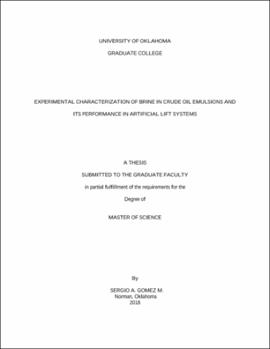| dc.description.abstract | Understanding the behavior of water in oil emulsions can prevent flow assurance problems and the conditions at which these two fluids can mix. The stability and rheology of water in crude oil emulsions was studied for three different factors. First, the effect of different concentrations of dissolved NaCl and CaCl2 in the aqueous phase is examined. Second, the effect of gas injection at different rates and exposure times is studied. Third, the effect of mixing using a centrifugal pump at different rates is investigated. Crude oils from wellheads in Midland, Texas were used and a non-ionic surfactant (Span 85) was utilized in some cases to stabilize the emulsion.
The results for brine in oil emulsions show different effects of salt on stability and viscosity for different water fractions. This effect can vary from a stability being proportional to the salt concentration in one case, to inversely proportional to the salt concentration in another case, including a case where a non-monotonic impact is registered. The viscosity increased in some cases with higher salt concentrations. As for gas lift, the results indicate that water in oil emulsions can be destabilized and its viscosity lowered after gas exposure. The effect of gas injection on the emulsion was linked to the initial conditions of the emulsion as well as the gas type, injection rate and time of exposure. Finally, a centrifugal pump resulted in creating stable emulsions at low water cuts, while it was not able to stabilize emulsions at high water fractions.
This research provides a comprehensive and exhaustive set of experiments on various measurements relating the water in oil emulsions. In some cases, it exhibits similar trends to what is described in the literature and in some cases contradicts them. This brings into question some of the theories that are used to explain this behavior given the complexity of water in crude oil emulsions. | en_US |
